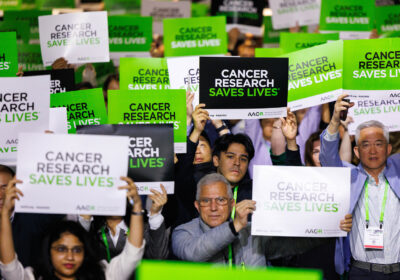The AACR Journals: Driving Progress in Cancer Science
The history of every scientific discipline can be found in the journals that contain the thousands of published studies that shape the field and propel it forward. The American Association for Cancer Research (AACR) is proud to publish eight influential journals that not only present the most recent findings in cancer science, but are also driving breakthroughs in the field.
The AACR’s publishing history is nearly as old as the organization itself, which was established in 1907. The first AACR publication, The Journal of Cancer Research, was launched in 1916. The journal was a milestone for the fledgling AACR and, as the first cancer journal published in English, for the field as a whole.
The inaugural issue included articles on a range of topics, from “The Mortality from Cancer in the Western Hemisphere” to “Chemotherapeutic Experiments on Rat Tumors.” Another study in the first issue, “Further Investigations on the Origin of Tumors in Mice: On the Part Played by Internal Secretion in the Spontaneous Development of Tumors,” was the first report to link hormones to cancer, a prescient finding that would influence the field of cancer prevention.
More seminal papers followed. In 1925, the journal published a study establishing the inheritability of some cancers, and in 1932, a study that reported early evidence linking smoking to cancer appeared in The American Journal of Cancer, which supplanted The Journal of Cancer Research in 1931. Ten years later, in 1941, the journal name was changed yet again, this time to Cancer Research. Over time, the journal would publish articles that led to the development of the chemotherapy drug 5-fluorouracil (5-FU), identified a successful treatment regimen for Hodgkin lymphoma, discovered that errors in DNA replication were responsible for the initiation and growth of cancerous tumors, and illustrated that the environment around the tumor helped tumors invade nearby tissue and spread to other organs.
Margaret Foti, PhD, MD (hc), the AACR’s chief executive officer, entered the organization as an editorial assistant for Cancer Research. Four years later, she was named the journal’s managing editor.
“From my experience as an editor for Cancer Research, I have seen firsthand the vital role this journal and the other outstanding journals published by the AACR have played in widely disseminating the latest developments in cancer research and all of its subfields.” said Dr. Foti.
Responding to the evolution of cancer research, the AACR launched three journals in the 1990s—Cell Growth & Differentiation in 1990 (which became Molecular Cancer Research in 2002); Cancer Epidemiology, Biomarkers & Prevention in 1991; and Clinical Cancer Research in 1995. The new millennium brought four new journals: Molecular Cancer Therapeutics in 2001, Cancer Prevention Research in 2008, Cancer Discovery in 2011, and Cancer Immunology Research in 2013.
The AACR has just announced that it will launch a new journal in 2020, Blood Cancer Discovery, which will provide a critical outlet for high-impact basic, translational, and clinical research on all disease subtypes of leukemia, lymphoma, myeloma, and associated diseases.
“Cancer researchers are making exciting discoveries daily that promise significant benefits for patients,” Dr. Foti added. “AACR journals offer publication outlets where remarkable developments in cancer science—including studies on precision medicine, immunotherapy, and advanced diagnostics—can be reported to our members and to the wider cancer community.”
The eight journals currently published by the AACR make up nearly 4 percent of the 222 oncology-specific journals officially indexed, but the studies they contain make up about 15 percent of all oncology-related scientific citations. The journals’ influence is reflected in their impact factors, rankings based on the number of times that journal articles are cited in other research papers. Currently, four AACR journals—Cancer Discovery, Clinical Cancer Research, Cancer Research, and Cancer Immunology Research—rank in the top 8 percent of oncology journals by impact factor. Historically, Cancer Research has ranked either first or second among cancer journals worldwide in terms of citation frequency.
“The AACR’s journals program focuses on the publication of critical information that contributes to important advances in the field,” said Christine Rullo, AACR vice president for scientific publications. “Ultimately, these advances will have a positive and lasting impact on patient care.”
Each year, about 12,500 manuscripts, on average, are submitted for publication to the eight journals’ editors. Of these, roughly 2,400 are selected for publication following a comprehensive peer-review process. By prioritizing turnaround times for authors, AACR journals publish the most cutting-edge content while ensuring rapid dissemination to cancer scientists worldwide. The most cited papers published in recent years include studies focusing on precision medicine, targeted therapy, and immunotherapy, which mirror the current hot topics in cancer research.
“We give precedence to studies conferring novel mechanistic insight into pathways linked to cancer risk, development, and progression,” explained Karen E. Knudsen, PhD, editor-in-chief of Molecular Cancer Research and enterprise director of the Sidney Kimmel Cancer Center at Thomas Jefferson University in Philadelphia. Dr. Knudsen is also a member of the AACR Board of Directors. “The studies we publish are foundational and lay the molecular groundwork for future studies directed toward cancer prevention, detection, and cure.”
Each editor-in-chief of the AACR’s journals works with a team of deputy and senior editors to select the studies they believe will contribute most to their fields. “Having the responsibility of editor-in-chief of Cancer Research is a remarkable honor,” said Chi Van Dang, MD, PhD, scientific director of the Ludwig Institute for Cancer Research, an international organization with headquarters in New York City, and professor in the Molecular and Cellular Oncogenesis Program at the Wistar Institute in Philadelphia. “We are able to shape the future of cancer research through the selection of the most impactful findings for publication.”
[ngg src=”galleries” ids=”11″ display=”basic_thumbnail” show_slideshow_link=”0″]





